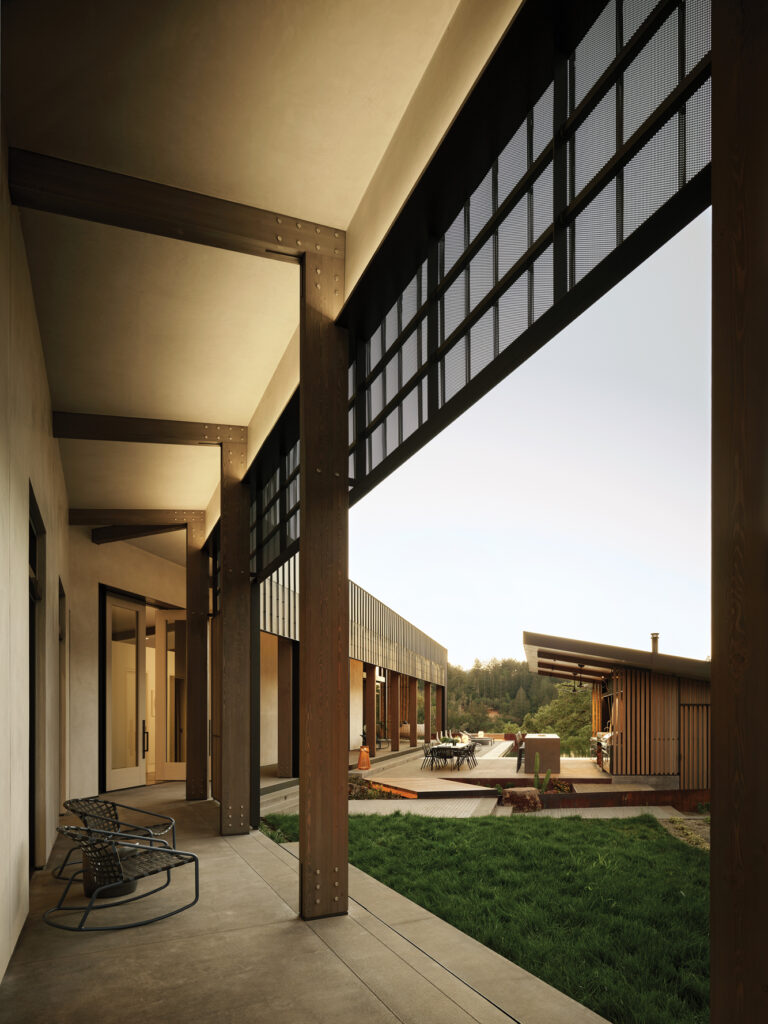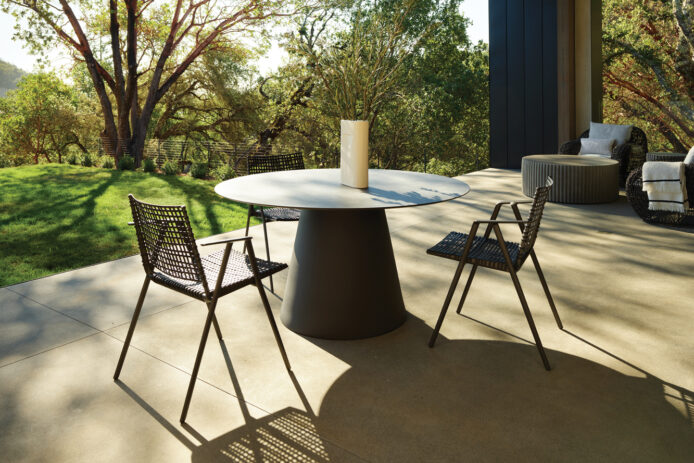
A Fire Country Home That’s Beautiful and Defensible
Two architects with extensive knowledge of fire-resistant building practices share their expertise and their hopes for rebuilding communities that are stronger, safer, and more resilient than before.

As with most Californians, fire-resistant home design is a topic of interest and fascination for me, regardless of the fact that I’ve never lived near a tinder-dry hillside or hard-to-reach canyon. Fires have always reshaped the landscape and threatened communities across the state, and I’ve watched in horror from a safe distance as they burned. Unlike other natural disasters, such as the random strikes of a tornado or the spontaneous jolt of an earthquake, “fire zones” foolishly seemed to me like things that could be avoided—as long as I didn’t build along a mountain ridge and lived tucked in among neighbors in densely populated, semi-urban communities.
That false perception changed this January when the Eaton and Palisades Fires started to incinerate beloved, long-established neighborhoods on opposite sides of town, and evacuation warnings were issued from Malibu to Pasadena to the Hollywood Hills. More than 12,000 structures were lost. Wide swaths of the largest county in the U.S. were blanketed in ash. Tragically, over two dozen people perished. And the devastation of the Los Angeles fires was a reality check for millions, including me. When the evacuation warnings started screaming from my phone, it was a wake-up call. If you live in the modern West, you live in a fire zone.

Matthew Millman
Over the last handful of years, blazes have torn through wide swaths of Oregon, New Mexico, and the Rocky Mountains. Dense smoke is a regular health hazard for the entire region. This is our collective reality.
“One-third of the U.S. population lives in the WUI—the wildlife/urban interface. It’s actually far, far more common than you’d think that we’re building or have built homes in vulnerable areas when it comes to fire,” says Christopher Roach, one of two principal architects at Studio VARA, a San Francisco-based firm. Roach and his partner Maura Fernandez Abernethy regularly design projects for the rural areas around the Bay Area, and implement comprehensive plans to “harden” the properties they build. “There is really no true distinction between urban and wild land. For sure, there are places that are much more truly remote. But it’s an issue that’s not isolated to ‘out there.’”
Just days before 200,000 residents of my community were forced to leave their homes and the city was smothered in smoke, I’d been admiring photos of a vacation home Studio VARA designed near Healdsburg, California, dubbed “Fire Country Lookout.” It’s an off-grid paradise with crisp, minimal lines and a simple, organic elegance. There are breezeways, smooth concrete floors, and outdoor living rooms bathed in golden light. Its beauty is matched only by its practicality and an awareness of the increasingly volatile landscape in which it resides. And the property could serve as inspiration for anyone who wishes to build, or rebuild, with the threat of fire in mind. Abernethy and Roach describe the home’s multi-prong defense systems as “layers of an onion,” a process that began when they helped their clients select the 15-acre parcel, with an established well and septic system, to build on.

Matthew Millman
“One critical element is that there were two ways out of the property, which was at the top of a hill, for evacuation and access. It was not on a dead-end street,” says Roach. “We did a pretty thorough analysis of the land and made improvements to the driveway, which was not up to Sonoma County fire standards. After we did a survey, we came up with a plan to clear trees and brush from around the building site and mapped out a series of trails coming down from the top of the hill. That gave the clients access to the full property, which has all these different and beautiful landscapes and created necessary firebreaks.”
They found evidence on the land that it had burned relatively recently, and there were many young coniferous trees that had grown in the years since. Those young pines, Roach says, are like “matchsticks” and need to be removed.

Matthew Millman
“Essentially, we started with a forest and turned it into a park,” says Abernethy. “We limbed all of the trees to remove the lower branches, which is considered ladder fuel, and exposed the beautiful trunks of the coast live oaks, which are critical habitat and essential to the landscape.”
From the beginning of the design process, durability was top of mind.
“We conceived of the house as being wrapped in a kind of protective shell,” says Roach. “Zinc, which is the metal on the home’s exterior, became our material of choice. It’s lightweight. You could wrap a house in concrete for ultimate protection, but it’s heavy and expensive. So by creating a more lightweight structure with a wood frame covered in stucco and plaster that’s wrapped in zinc, it has that effect of being noncombustible and also very low maintenance. The natural finish weathers and ages in time and doesn’t need a coating or a finish.”

Matthew Millman
For the interior, Abernethy chose a limited material palette of polished concrete floors, oak cabinetry, and glass.
“Everything inside of the metal cocoon is made of noncombustible materials,” she says. “Even if it was smoke-tainted, it would not require much effort to repair and restore it.”
The homeowners, at their architects’ urging, also invested in a rooftop fire retardant foam dispersion and sprinkler system from Frontline to create a 30-foot protection zone around the home. In lieu of more conventional landscaping, gravel pads surround the building to create a protective five-foot “ember zone” without vegetation.
Roach and Abernethy emphasize that the home’s systems, which include concrete cisterns for water storage, photovoltaic solar panels, whole-house Tesla batteries to store power, and a backup diesel generator, increase the property’s true fire resistance exponentially and demonstrate the intersection of sustainability and resilience.

Matthew Millman
“The building is connected to the local Pacific Gas & Electric power grid, but in the event of a windstorm or a fire event, they turn the power off,” says Roach. “They have solar with batteries to provide clean power to the house, but they also provide a redundancy, so if the power is cut off, the pumps to the sprinklers still work, and firefighters can access the well water.”
After they poured the foundation of the house, their extensive research and planning proved prescient. Fire broke out in a nearby canyon, and their site supervisor sent them a video of the construction site with a glowing orange sky in the distance.

Matthew Millman
Most of us do not have the luxury of building a home from the ground up with state-of-the art materials or have acres of volatile forest-like grounds that need management. But we can take cues from properties like this one to improve existing structures, and, in the bigger picture, encourage city planners and municipal developers to rebuild communities in safer, more thoughtful, and resilient ways.
“You might not need to build fire trails on your land, but you can think outwardly. You can think about your neighbors and coordinate and cooperate and encourage each other to manage the landscape, remove brush, and limb trees. You can retrofit vents under the eaves of your house so they close off with heat and create a five-foot ember zone right around your house. You can avoid combustible plantings and wood decks right next to your house,” says Roach.
Roach also stresses the importance of installing multiple-function backup power systems, like solar panels with battery storage, so when power is shut off, water pumps can still function.

Matthew Millman
“People often think and act in ad hoc ways, replacing siding and trimming trees, but thinking a little more holistically and understanding the interactions between each of those components is the key,” says Roach. “That’s the definition of resilience, really. If you take away one part, the whole thing still holds together.”
The outpouring of support in Los Angeles has not gone unnoticed by our neighbors up north and in surrounding states.
“It’s been unbelievable to watch from afar,” Abernethy says. Her wish, as an architect who grew up in Pasadena, is that the focus and supportive spirit remains intact long after the literal smoke clears.
“Our hope is that the city can continue this tremendous community spirit when it comes time to rebuild.”
